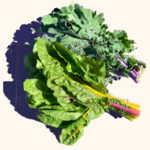hearty greens
We grow greens during the cool seasons which means winter, spring and fall on our farm. Storage for bunched greens is fairly similar across the board- store them in your refrigerator, unwashed, and in a bag that will help keep them from wilting. Most of these greens can be eaten raw or cooked. If eating raw, they usually benefit from a bit of massaging to tenderize the leaves.
Broccoli Raab: Also spelled “rabe,” it’s part of the turnip family and tastes like turnip greens, not like broccoli. It has small florets and leaves. It can be a bit more on the bitter and earthy side, it’s often recommended that you first blanch and then sauté, but blanching isn’t necessary and you can skip that step and just sauté.
Chard: The green, gold, and red chard leaves harvested at Full Belly are rich in color and nutrients. Chard can be steamed, sautéed, or added to soup or salad.
Collards: Collards are closely related to cabbage and have beautiful, blue-grey, flat leaves. They can be remarkably sweet.
Kale: One cup of loosely packed Kale eaten raw provides over 100% of the recommended daily vitamin K for adults. Kale is also rich in Vitamins A and C, and contains a fair amount of copper, iron, and calcium. Kale can be added to soups, salads, omelets, or sautéed into a stir fry. Can't get your kids to eat it? Try making kale chips by stripping the leaves off the stem, placing leaves on a baking sheet, sprinkling with salt and olive oil, and baking until crispy. Don't throw out the stems - they're sweet and crunchy. You can cook them separately from the leaves or use them in the same dish, but consider adding a little extra cooking time.
Spigarello: Do you like dino kale and collards? If so, you’ll love spigarello. Also known as leaf broccoli, its taste and texture are somewhere between collards and dino kale and you can use it in most of the greens recipes on our website that call for kale or collards.
And don't forget about Beet Greens! The greens on the beets are delicious too. They're like slightly thicker chard (which makes sense; chard and beets are related) and can be used anywhere you'd use chard, just with slightly more cooking time.
Again: all greens should be stored in a refrigerator with something that will help keep in the moisture. If they do start to wilt, don't despair - they can be revived with cold water: cut the thick stems back about 1/2" to expose a new open end, then submerge leaves and stems in water, making sure that any cut ends are fully submerged. Soak for at least 30 minutes. Note that heavy and extremely wilted leaves may take more time. This tip does not work for leaves that have already yellowed or become slimy. If some leaves are too far gone, try removing those and soaking the remaining leaves that are still intact. Thanks to StopFoodWaste for the tips!

